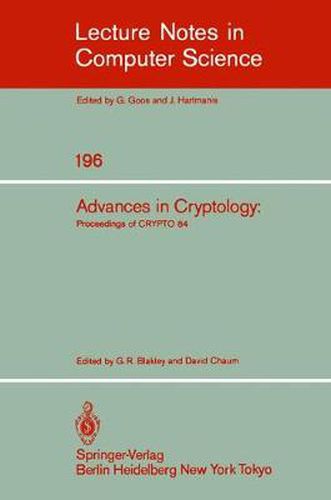Readings Newsletter
Become a Readings Member to make your shopping experience even easier.
Sign in or sign up for free!
You’re not far away from qualifying for FREE standard shipping within Australia
You’ve qualified for FREE standard shipping within Australia
The cart is loading…






This title is printed to order. This book may have been self-published. If so, we cannot guarantee the quality of the content. In the main most books will have gone through the editing process however some may not. We therefore suggest that you be aware of this before ordering this book. If in doubt check either the author or publisher’s details as we are unable to accept any returns unless they are faulty. Please contact us if you have any questions.
Recently, there has been a lot of interest in provably good pseudo-random number generators [lo, 4, 14, 31. These cryptographically secure generators are good in the sense that they pass all probabilistic polynomial time statistical tests. However, despite these nice properties, the secure generators known so far suffer from the han- cap of being inefiicient; the most efiicient of these take n2 steps (one modular multip- cation, n being the length of the seed) to generate one bit. Pseudc-random number g- erators that are currently used in practice output n bits per multiplication (n2 steps). An important open problem was to output even two bits on each multiplication in a cryptographically secure way. This problem was stated by Blum, Blum & Shub [3] in the context of their z2 mod N generator. They further ask: how many bits can be o- put per multiplication, maintaining cryptographic security? In this paper we state a simple condition, the XOR-Condition and show that any generator satisfying this condition can output logn bits on each multiplication. We show that the XOR-Condition is satisfied by the lop least significant bits of the z2-mod N generator. The security of the z2 mod N generator was based on Quadratic Residu- ity [3]. This generator is an example of a Trapdoor Generator [13], and its trapdoor properties have been used in protocol design. We strengthen the security of this gene- tor by proving it as hard as factoring.
$9.00 standard shipping within Australia
FREE standard shipping within Australia for orders over $100.00
Express & International shipping calculated at checkout
This title is printed to order. This book may have been self-published. If so, we cannot guarantee the quality of the content. In the main most books will have gone through the editing process however some may not. We therefore suggest that you be aware of this before ordering this book. If in doubt check either the author or publisher’s details as we are unable to accept any returns unless they are faulty. Please contact us if you have any questions.
Recently, there has been a lot of interest in provably good pseudo-random number generators [lo, 4, 14, 31. These cryptographically secure generators are good in the sense that they pass all probabilistic polynomial time statistical tests. However, despite these nice properties, the secure generators known so far suffer from the han- cap of being inefiicient; the most efiicient of these take n2 steps (one modular multip- cation, n being the length of the seed) to generate one bit. Pseudc-random number g- erators that are currently used in practice output n bits per multiplication (n2 steps). An important open problem was to output even two bits on each multiplication in a cryptographically secure way. This problem was stated by Blum, Blum & Shub [3] in the context of their z2 mod N generator. They further ask: how many bits can be o- put per multiplication, maintaining cryptographic security? In this paper we state a simple condition, the XOR-Condition and show that any generator satisfying this condition can output logn bits on each multiplication. We show that the XOR-Condition is satisfied by the lop least significant bits of the z2-mod N generator. The security of the z2 mod N generator was based on Quadratic Residu- ity [3]. This generator is an example of a Trapdoor Generator [13], and its trapdoor properties have been used in protocol design. We strengthen the security of this gene- tor by proving it as hard as factoring.